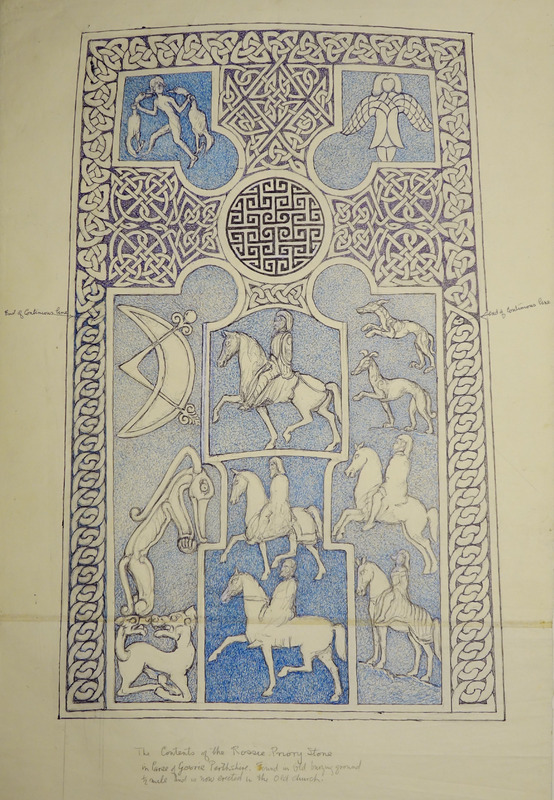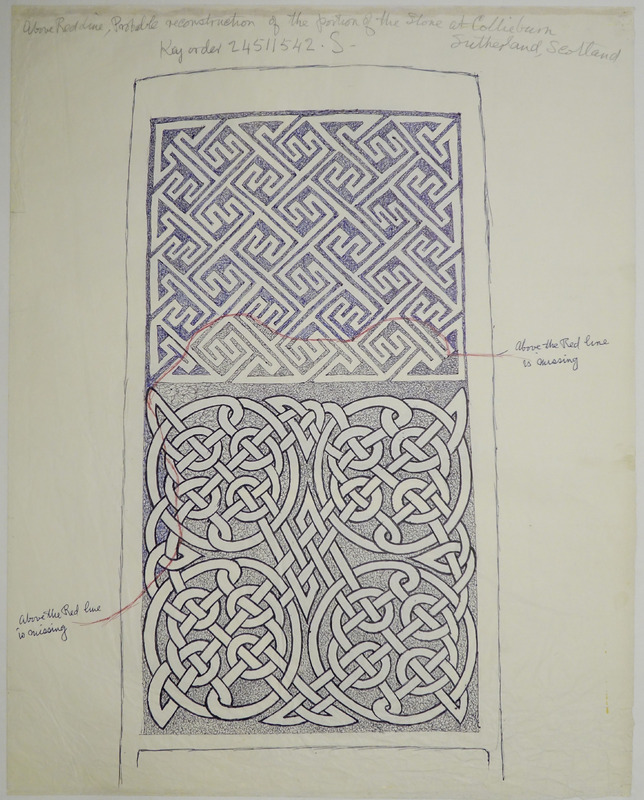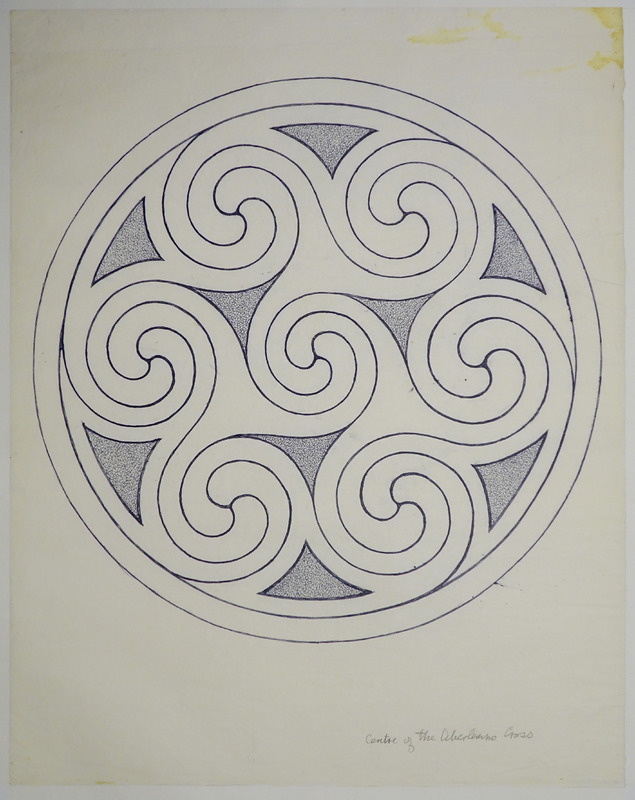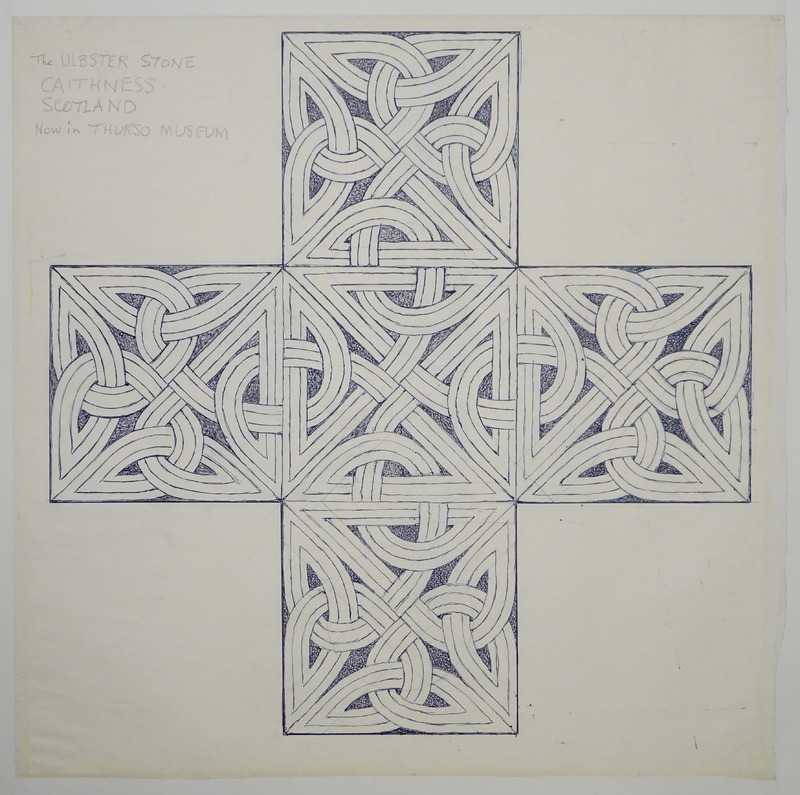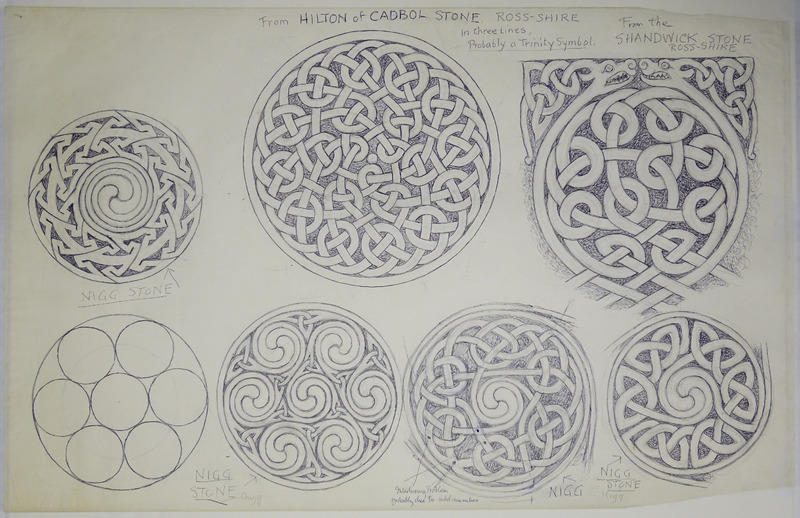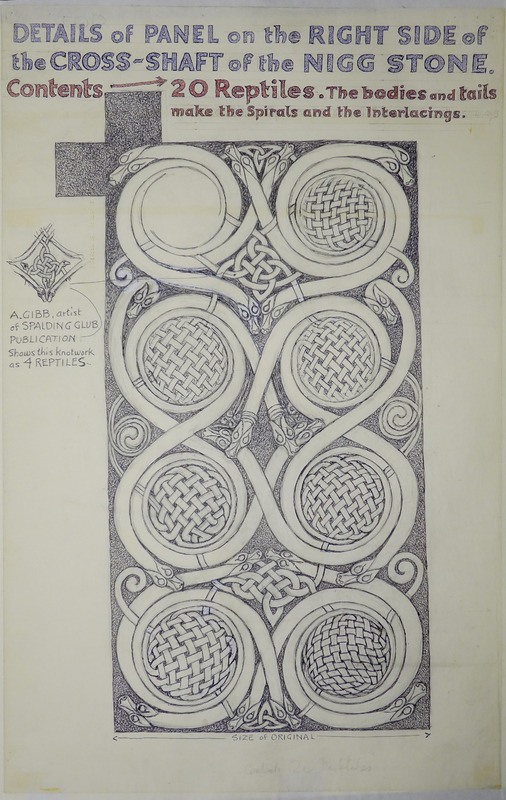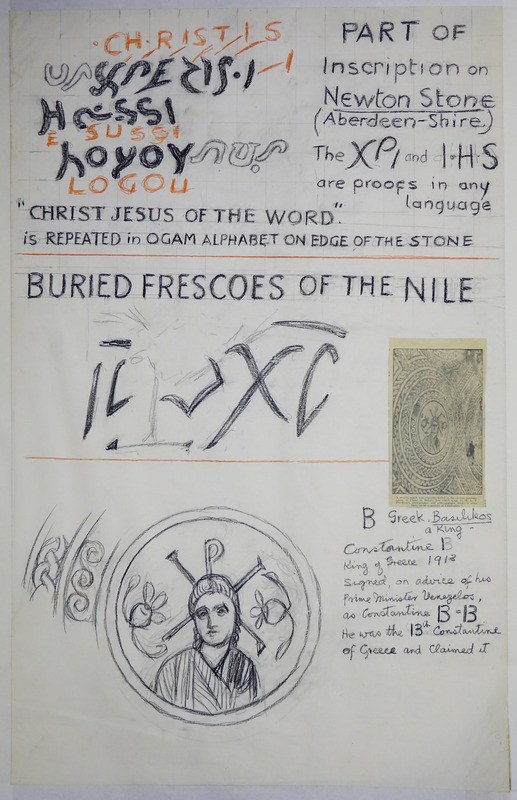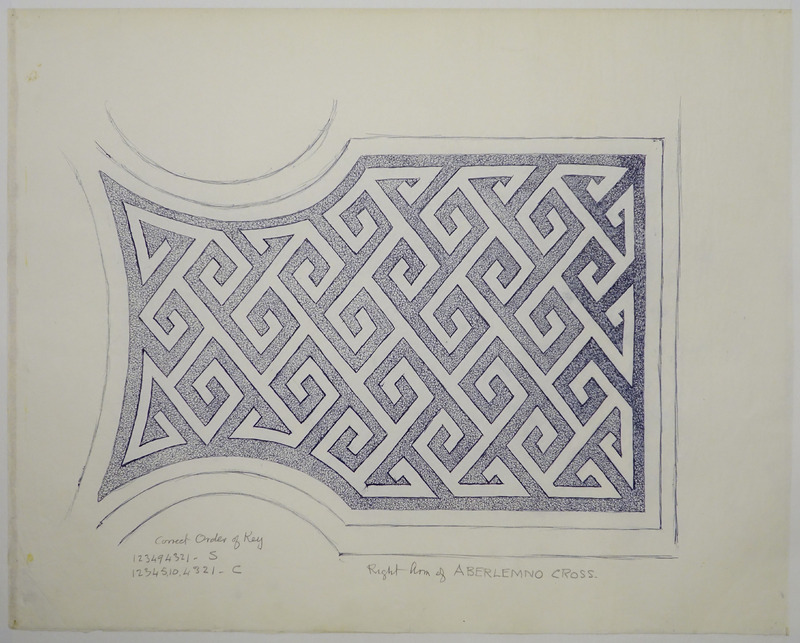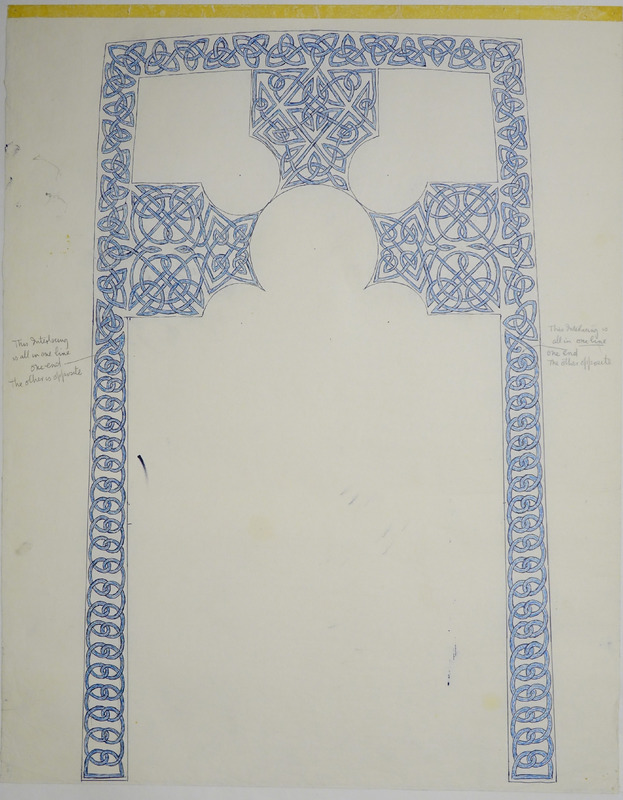Rossie Priory Stone
Class II symbol stone.
One of the most impressive Early Christian monuments of south-east Perth, this cross-slab is in the former church of Rossie, which is now the mausoleum of the Kinnaird family. Decorated in relief on both faces, it measures 1.67m in height, 1.16m in width at the base and up to 0.3m in thickness. The front is decorated with a cross in high relief, lacking the left arm; the cross is ringed and has rounded hollow armpits and a central roundel of interlace. The top arm and shaft are decorated with panels of interlace, while the surviving arm bears key pattern. The panels on either side of the head contain, on the left, a beast with a human head and curling tail; on the other side, a beaked figure holding an axe with both hands attacks a claw-footed bird. On the left side of the shaft are carved a beast with its tail curled over its back; a naked man under attack from a beast and a fish-tailed monster; and a pair of confronted beasts, each swallowing a bird. On the right-hand side of the shaft there is a beast swallowing a serpent; below this there is an animal with a bovine head and large eyes. At the bottom of the slab there is a pair of monsters with human heads, the fins of a fish and beast-headed tails, bodies intertwined, facing in opposite directions, one astride the other; their beards and flowing hair are very clearly shown. On the back of the slab, a second cross, set within an interlaced border, is the dominant feature. There is an animal head just below the left arm of the cross where the interlace begins, with the pattern ending in a fish-like tail below the right arm. The almost equal-armed cross has rounded hollow armpits and a central roundel of key pattern and interlace decoration in the arms, which merges into that of the border. The short shaft and its stepped base are outlined by beading and contain figural decoration: three horsemen ranged vertically form a hunting scene with two further horsemen and a pair of hunting dogs on the right-hand side of the shaft. In the spaces above the side-arms of the cross are carved an angel and a figure holding a pair of birds by the necks. Finally, on the left-hand side of the shaft and pedestal there are a crescent and V-rod, a 'Pictish beast', and a kneeling animal looking back at the head which forms the termination of its tail.
Collieburn Stone
Cist and Cross Slab. The lower part of an upright cross-slab of yellow sandstone was found erect under 7 feet of sand during the railway excavations near Collieburn, Sutherland, Scotland in 1869. It is 5 ft 2 inches high and sculptured in relief on two faces, with double-headed knot-work, a swastika cross, a key pattern and small circular bosses. The slab appears to have been re-used as a door jamb or similar secondary purpose. It is in Dunrobin Museum.
George Bains drawing depicts - 'Above red line, probable reconstruction of the portion of the stone (missing) at Collieburn, Sutherland, Scotland'.
Aberlemno Cross Slab
This Drawing shows the detail of the spiral arangment from the centre of the celtic cross of the front of the Aberlemno Cross.
The well preserved Pictish Cross-Slab in Aberlemno Kirkyard is sculpted with a Celtic Cross in relief and a background of intertwined beasts.
The reverse of the Cross-Slab has a panel showing a battle scene with long-haired Pictish warriors fighting Northumbrians wearing helmets with nose guards. There are warriors and horsemen bearing spears, swords and shields, and a dying Northumbrian being pecked by a raven. This is thought to portray the Battle of Dunnichen which took place only 10 km from Aberlemno.
Ulbster Stone
Class II symbol stone.
This drawing shows the cross detail on the back of the stone. Also on the back of the stone is an elephant over a salmon, a crescent and V-rod over a beast, a fish-monster over a step and a double-disc over a double-crescent.
On the face of the stone, above another cross is carved a cow and other animals. Below the cross are two kneeling figures with a cauldron together with a horse and a colt. Below these is a serpent and a flower to the right.
Hilton of Cadboll Stone
Detailed drawings compairing disc designs from various stones, the Shadwick Stone, the Nigg Stone and the Hilton of Cadboll Stone.
The stone was discovered at Hilton of Cadboll, on the East coast of the Tarbat Peninsula in Easter Ross, Scotland. Class II Pictish stone.
On the seaward-facing side is a Christian cross, and on the landward facing side are secular depictions. The latter are carved below the Pictish symbols of crescent and v-rod and double disc and Z-rod: a hunting scene including a woman wearing a large penannular brooch riding side-saddle. Like other similar stones, it can be dated to about 800 AD.
Nigg Stone
Class II Pictish cross-slab.
The stone was originally located at the gateway to the grounds of the parish church of Nigg, Easter Ross. It is one of the finest surviving Pictish carved stones, and one of the most elaborate carved stones surviving from early medieval Europe. It is now displayed, restored to its original proportions, in a room inside the parish church (open in summer; key kept locally). It bears an elaborately decorated cross in high relief on the 'front' and a figural scene on the reverse. This scene is extremely complicated and made more difficult to interpret by deliberate defacement. Among the depictions are two Pictish symbols: an eagle above a Pictish Beast, a sheep, the oldest evidence of a European triangular harp, and hunting scenes. Scholars interpret the scene as representing a story of the biblical King David. The carvings on the cross side show close similarities to the contemporary high crosses of Iona. These works may indeed have been created by the same 'school' of carvers, working for different patrons. The stone was shattered in the 18th century. The upper and lower parts were crudely joined together using metal staples (now removed), and the shattered intervening part was discarded. Part of the missing fragment was recovered in 1998 by Niall M Robertson, in the stream which runs below the mound on which the churchyard is set, having probably been thrown down the bank at the time the slab was 'repaired'. This small fragment shows most of the 'Pictish beast' symbol, and was preserved in Tain Museum, until being reattached during a restoration in 2013.
The Newton Stone
The Newton Stone is a pillar stone, found in Aberdeenshire, Scotland. The stone contains two inscriptions, one, written in Ogham, but the second script has never been positively identified and many different decipherments or theories have been proposed since the 1860s.
The Newton Stone contains two inscriptions. The first is an Ogham script possibly containing personal names, while the second has never been identified and became known from the early 19th century as the "unknown script". The Ogham script is engraved down the left-hand side of the stone and runs across part of its face. There are two rows of Ogham, a long and a short row. Across the top third of the stone, roughly central, is the unidentified script which contains 6 lines comprising 48 characters and symbols, including a swastika.
The second script may have been added to the stone as recent as the late 18th or beginning of the 19th century.
Knossos Tablets
'This stone and other suggest prehistoric connection with Scottish Celts and Mycenaean etc cultures'. - George Bain.
The name Knossos survives from ancient Greek references to the major city of Crete.
Knossos is the largest Bronze Age archaeological site on Crete and is considered Europe's oldest city.
Aberlemno Cross Slab
This drawing highlights a Key Pattern detail from Aberlemno Cross Slab.
The well preserved Pictish Cross-Slab in Aberlemno Kirkyard is sculpted with a Celtic Cross in relief and a background of intertwined beasts.
The reverse of the Cross-Slab has a panel showing a battle scene with long-haired Pictish warriors fighting Northumbrians wearing helmets with nose guards. There are warriors and horsemen bearing spears, swords and shields, and a dying Northumbrian being pecked by a raven. This is thought to portray the Battle of Dunnichen which took place only 10 km from Aberlemno.
Rossie Priory Stone
Class II symbol stone. One of the most impressive Early Christian monuments of south-east Perth, this cross-slab is in the former church of Rossie, which is now the mausoleum of the Kinnaird family. Decorated in relief on both faces, it measures 1.67m in height, 1.16m in width at the base and up to 0.3m in thickness. The front is decorated with a cross in high relief, lacking the left arm; the cross is ringed and has rounded hollow armpits and a central roundel of interlace. The top arm and shaft are decorated with panels of interlace, while the surviving arm bears key pattern. The panels on either side of the head contain, on the left, a beast with a human head and curling tail; on the other side, a beaked figure holding an axe with both hands attacks a claw-footed bird. On the left side of the shaft are carved a beast with its tail curled over its back; a naked man under attack from a beast and a fish-tailed monster; and a pair of confronted beasts, each swallowing a bird. On the right-hand side of the shaft there is a beast swallowing a serpent; below this there is an animal with a bovine head and large eyes. At the bottom of the slab there is a pair of monsters with human heads, the fins of a fish and beast-headed tails, bodies intertwined, facing in opposite directions, one astride the other; their beards and flowing hair are very clearly shown. On the back of the slab, a second cross, set within an interlaced border, is the dominant feature. There is an animal head just below the left arm of the cross where the interlace begins, with the pattern ending in a fish-like tail below the right arm. The almost equal-armed cross has rounded hollow armpits and a central roundel of key pattern and interlace decoration in the arms, which merges into that of the border. The short shaft and its stepped base are outlined by beading and contain figural decoration: three horsemen ranged vertically form a hunting scene with two further horsemen and a pair of hunting dogs on the right-hand side of the shaft. In the spaces above the side-arms of the cross are carved an angel and a figure holding a pair of birds by the necks. Finally, on the left-hand side of the shaft and pedestal there are a crescent and V-rod, a 'Pictish beast', and a kneeling animal looking back at the head which forms the termination of its tail.
'This interlacing is all in one line, one end, the other is opposite'. - George Bain.
